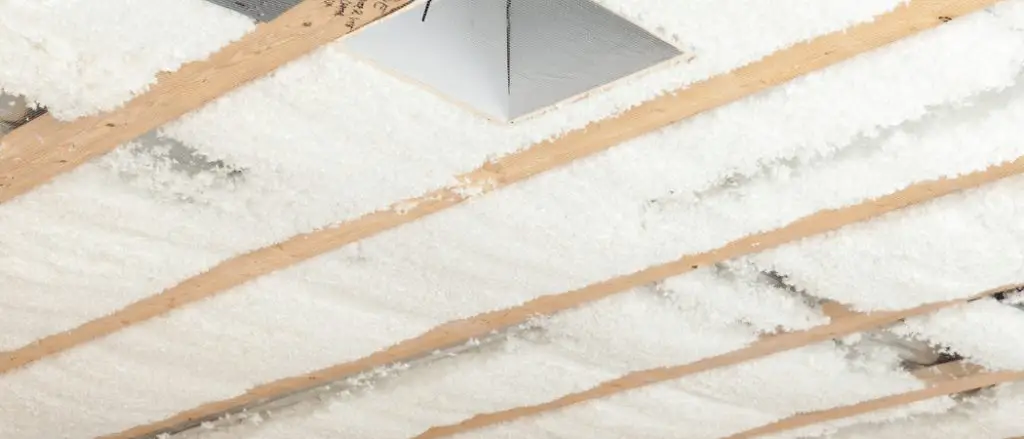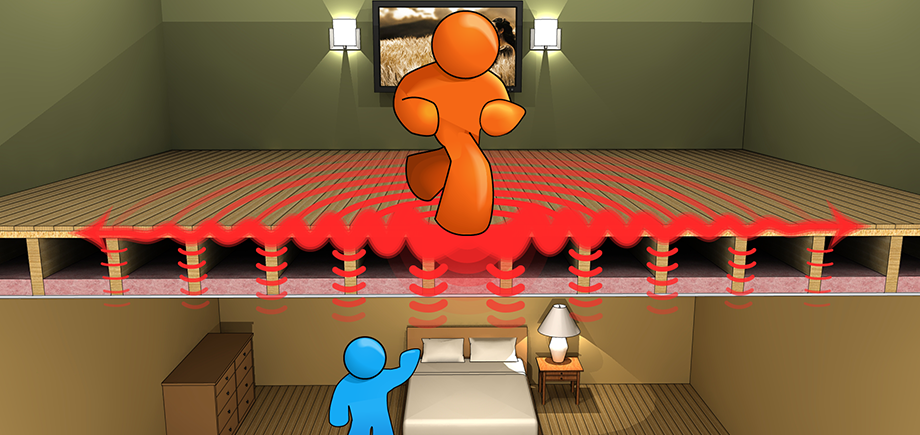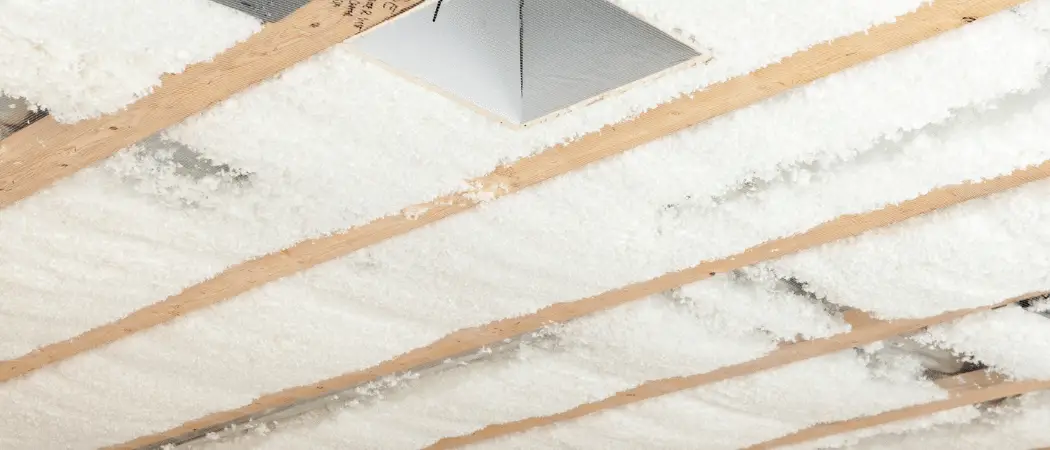To prevent sound from traveling upstairs, use carpets, rugs, or sound-dampening underlayment on the floors. Additionally, you can add heavy drapes, furniture, or acoustic panels to absorb noise and reduce echoes.
Soundproofing compound applied to ceilings can further minimize noise transmission. By addressing both impact noise from footsteps and airborne noise from voices or music, you can create a quieter living environment for both yourself and your upstairs neighbors. Proper insulation and sealing any gaps or cracks in walls and floors can also help in significantly reducing sound transfer between floors.
By implementing these soundproofing methods, you can enjoy a more peaceful and quiet living space.

Identifying The Problem
When it comes to soundproofing your home, one of the most common challenges is preventing sound from traveling upstairs. Whether it’s the sound of footsteps, loud music, or even conversations, unwanted noise from upstairs can disrupt the peace and quiet in your living space. Identifying the problem is the first step towards finding an effective solution. Here are the key factors you need to consider:
Floor Structure
The floor structure plays a crucial role in determining how much sound is transmitted from upstairs to downstairs. Understanding the type of floor you have is essential in addressing the problem. There are generally three types of floor structures:
- Solid Floors: Solid floors, typically made of concrete or other hard materials, offer better sound insulation compared to other types of flooring. They are more effective in reducing impact noise caused by activities such as walking or jumping.
- Tiled or Hardwood Floors: Tiled or hardwood floors can amplify sound due to their hard surfaces. They don’t provide much sound insulation and can allow noise to easily travel between floors.
- Carpeted Floors: Carpeted floors can help absorb and dampen sound. They provide better sound insulation compared to hard surfaces, making them a popular choice for reducing noise transmission.
Noise Sources
To effectively prevent sound from traveling upstairs, it’s crucial to identify the specific sources of noise. Knowing where the noise is coming from can help you determine the most appropriate solutions. Common noise sources include:
- Footsteps: Heavier footsteps or high heels on hard surfaces can produce significant noise that easily travels through the floor.
- Music or TV: Loud music or the sound from a TV can create vibration and noise that travels through walls and floors.
- Conversations: Loud conversations or even normal voices can carry through the floor, particularly if the floor structure is not adequately insulated.
By pinpointing the exact noise sources, you can focus your efforts on implementing targeted soundproofing measures to effectively reduce or eliminate the noise.

Understanding Sound Transmission
Sound transmission between floors can disrupt the peace and privacy of a home. By gaining insight into the different types of sound transmission, you can effectively address the issue at its core.
Airborne Sound
Airborne sound is generated from sources like voices, music, or TVs. It travels through the air and can easily pass through floorboards and walls, causing disturbances in rooms above or below.
Impact Sound
Impact sound, on the other hand, is created by physical impact on a surface, such as footsteps or dropping objects. This type of sound travels directly through floors and ceilings, making it more challenging to contain.
Common Soundproofing Techniques
Noisy neighbors or loud activities upstairs can be a major disruption. Implementing soundproofing techniques can help reduce the amount of noise that travels between floors. Here are some common soundproofing techniques that you can use to prevent sound from traveling upstairs.
Sealing Air Leaks
Sealing air leaks is a crucial step in preventing sound from traveling between floors. Weatherstripping around doors and windows and caulking any gaps and cracks can significantly reduce the transmission of sound. By eliminating the pathways through which sound can travel, you can effectively minimize the noise from upstairs.
Adding Insulation
Adding insulation to the ceiling of the lower floor and the floor of the upper floor can help absorb and block sound transmission. Fiberglass insulation between floor joists can effectively reduce airborne noise. Additionally, installing mass-loaded vinyl under the flooring material can further enhance the soundproofing capabilities.
Using Soundproofing Materials
Using soundproofing materials is a practical way to reduce noise transmission between floors. By adding specific materials, you can significantly minimize the impact of footsteps, conversations, and other sounds traveling from the lower levels to the upper floors. There are several soundproofing materials available in the market, each with its unique properties and functions.
Mass Loaded Vinyl
Mass Loaded Vinyl (MLV) is a dense, flexible material that effectively blocks airborne sound transmission. It is commonly used as a sound barrier in walls, ceilings, and floors. MLV can be installed under flooring or within walls to minimize impact noise and airborne sound. Its high mass and flexibility make it an excellent choice for soundproofing against various frequencies.
Acoustic Foam
Acoustic foam panels are designed to absorb sound waves, reducing reverberation and echo within a room. While they are typically used for interior walls and ceilings to improve the acoustics within a space, they can also be effective in reducing noise transfer between floors. By installing acoustic foam underneath the flooring or on the ceiling of the lower level, you can minimize the transmission of sound to the floor above, creating a quieter environment.
Enhancing Floor Structure
Enhancing the floor structure is an effective way to prevent sound from traveling upstairs. By improving the construction of the floor, you can minimize the transmission of noise, creating a peaceful and serene environment in your home.
Float The Floor
Floating the floor involves creating a separate, isolated structure that is not directly attached to the existing floor or subfloor. This method helps to reduce impact noise and prevents vibrations from traveling to the floor below.
Install Resilient Underlayment
Resilient underlayment materials, such as rubber or cork, provide a cushioning effect that absorbs and reduces the transmission of sound. Installing resilient underlayment beneath the flooring helps to create a barrier against impact and airborne noise, contributing to a quieter living space.
Addressing Noise Sources
To prevent sound from traveling upstairs, it is essential to address noise sources effectively. By installing soundproofing materials, sealing gaps, and using carpets or area rugs, you can reduce the impact of noise transmission between floors. Strategically placing heavy furniture can also help absorb sound vibrations and minimize sound disturbances.
Carpets And Rugs
One effective way to prevent sound from traveling upstairs is by adding carpets and rugs to the lower floor. Thick and plush carpets and rugs help to absorb sound vibrations, reducing the noise that reaches the upper floor. The soft fibers of the carpet trap sound waves and prevent them from bouncing off hard surfaces, resulting in less sound transmission to the floor above. Additionally, carpets and rugs provide insulation, which further helps to reduce noise transmission. By strategically placing carpets or rugs in high-traffic areas or areas directly above noisy rooms, you can significantly minimize noise traveling upstairs.
Sound Dampening Curtains
Another effective solution for addressing noise sources is to install sound-dampening curtains. These specialized curtains are made of thick, heavy materials that are designed to absorb sound and reduce echo. Sound dampening curtains typically have multiple layers and include a dense inner lining that helps to block noise from entering or exiting the room. By hanging these curtains over windows or even as room dividers, you can effectively prevent sound from traveling upstairs. Sound dampening curtains are available in a variety of styles, colors, and designs, allowing you to choose options that suit your decor while providing excellent noise reduction.
Dealing With Impact Noise
Prevent sound from traveling upstairs with these tips to deal with impact noise. Create a quieter environment by adding carpeting or rugs, using sound-absorbing materials, sealing gaps, and installing a suspended ceiling or acoustic barriers.
When it comes to preventing sound from traveling upstairs, dealing with impact noise is essential. Impact noise, which occurs when an object hits or drops on the floor, can be a major source of disturbance. Fortunately, there are effective solutions that can help minimize impact noise and create a quieter environment upstairs.
Using Floor Mats
One simple and cost-effective way to reduce impact noise is by using floor mats. These mats act as a cushioning barrier, absorbing the impact and preventing the sound from traveling through the floor. Place them strategically in areas where impact noise is most likely to occur, such as in the hallway or near staircases.
Choose floor mats that are specifically designed for noise reduction and are made of materials like dense rubber or cork. These materials are known for their sound-absorbing properties. Additionally, make sure that the mats cover a large surface area to effectively dampen the impact noise.
Resilient Channel Installation
Another effective method to combat impact noise is through resilient channel installation. Resilient channels are specially designed metal strips that are installed between the floor joists and the subfloor. These channels help to break the direct contact between the floor and the ceiling, reducing the transmission of impact noise.
The installation process involves screwing the resilient channels to the sides of the joists, creating a gap between the subfloor and the joists. This gap acts as a decoupling mechanism, preventing the vibrations from traveling through the floor structure. Once the channels are installed, you can then attach the new subfloor or flooring material.
It is important to note that resilient channel installation is a task best left to professionals, as it requires precise measurements and proper installation techniques. Hiring a skilled contractor will ensure that the channels are installed correctly and maximize their effectiveness in reducing impact noise.
| Advantages of Using Floor Mats | Advantages of Resilient Channel Installation |
|---|---|
|
|
By using floor mats and considering resilient channel installation, you can effectively tackle impact noise and create a quieter upstairs living space. Choose a combination of methods that best suits your needs and budget, and enjoy the peace and tranquility that comes with soundproofing your home.

Professional Soundproofing Solutions
Looking for professional soundproofing solutions to prevent sound from traveling upstairs? Our expert team provides effective and efficient soundproofing techniques that will ensure a quiet and peaceful environment for your home or office. Say goodbye to noise disturbances with our top-notch soundproofing solutions.
Consulting Soundproofing Experts
Consult with professionals for tailored advice on soundproofing needs.
Installing Soundproofing Systems
Implement soundproofing solutions to minimize noise transfer in your home.
Professional soundproofing solutions are essential for maintaining a peaceful living environment. Consulting soundproofing experts can provide personalized recommendations based on your specific requirements. They will assess the layout of your home and suggest the most effective soundproofing systems to prevent noise from traveling upstairs.
When considering soundproofing options, it’s crucial to seek guidance from experienced professionals. By enlisting the help of experts, you can ensure that the chosen solutions are suitable for your unique situation. Installing soundproofing systems will significantly reduce the transmission of sound between different areas of your home.
Whether you are dealing with loud footsteps, conversations, or music from upstairs, professional soundproofing solutions can make a noticeable difference. Trusting the expertise of soundproofing specialists will help you create a quieter and more comfortable living space. Partnering with professionals ensures that your soundproofing efforts are effective and long-lasting.
Frequently Asked Questions Of How To Prevent Sound From Traveling Upstairs
How Do I Stop My Sound From Traveling Upstairs?
To prevent sound from traveling upstairs: 1. Use thick carpets or rugs to absorb sound. 2. Install curtains or acoustic panels on walls. 3. Seal any gaps or holes to minimize sound leakage. 4. Consider using soundproofing materials like acoustic foam or insulation.
5. Use door sweeps or draft stoppers to block sound transmission under doors.
How Do I Stop Noise Transfer Between Floors?
To stop noise transfer between floors, consider these effective methods: 1. Use acoustic underlay and carpeting to absorb sound vibrations. 2. Install soundproofing materials on walls and ceilings. 3. Seal any gaps or cracks in the floors to prevent sound leakage.
4. Add area rugs and thick curtains to further dampen noise. 5. Place furniture, like bookshelves, to act as sound barriers between floors.
How Do I Stop Sound From Traveling Through My House?
To stop sound from traveling through your house, use thick curtains, weatherstripping, and rugs to absorb sound. Adding wall insulation or acoustic panels can also reduce sound transmission. Lastly, sealing gaps around windows and doors can minimize sound transfer.
How Do I Stop Sound Traveling Through My Ceiling?
To stop sound traveling through your ceiling, install acoustic panels, rugs, or ceiling baffles. Sealing gaps and cracks can also help.
Conclusion
To effectively prevent sound from traveling upstairs, implementing proper insulation and soundproofing materials is key. By addressing gaps, using carpets, and adding sound barriers, you can significantly minimize noise transmission. Maintaining mindful habits and communication with neighbors can also contribute to a quieter living environment.

